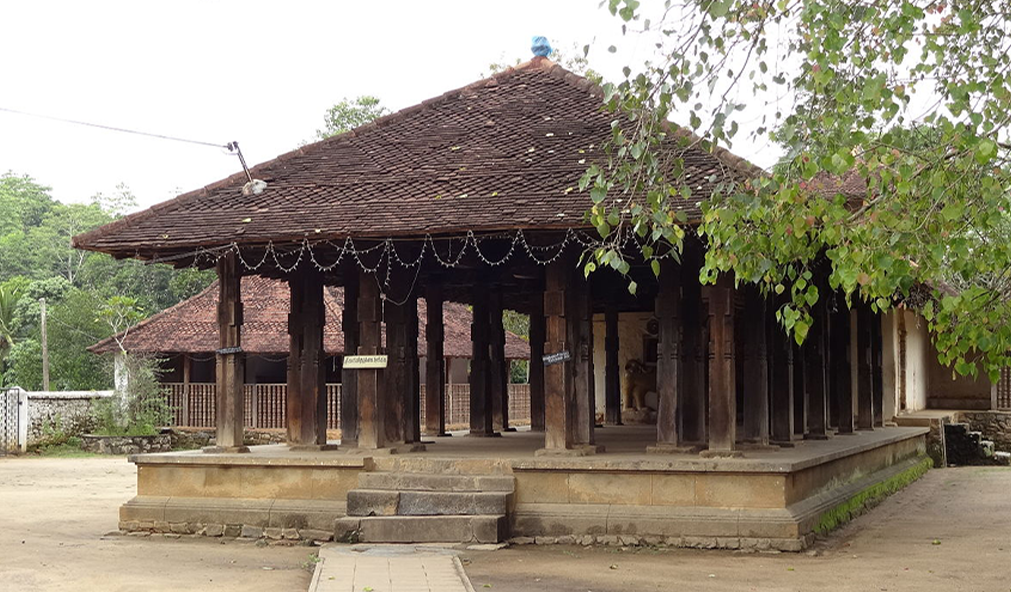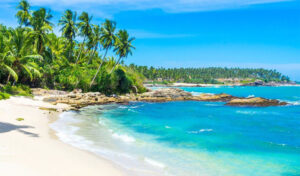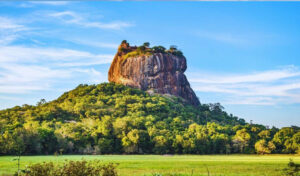Built over six centuries ago, Embekka Devalaya is an artistic masterpiece. It has some of the most intricate and beautiful wood carvings to be seen in Sri Lanka, or anywhere in the world for that matter. The quality of the artistry is matched by the quantity, for almost the entire temple is covered in carvings.
Located in the Udu Nuwara area of the Kandy District, the temple was constructed during the reign of King Wickramabahu III who ruled from 1371 to 1394, during the Gampola era. There are many legends surrounding the origins of the temple. The most popular one narrates the story of a drummer who made a pilgrimage to Kataragama seeking healing from an acute skin disease. Upon recovery he made a pledge to Lord Kataragama that he would make an annual pilgrimage to the temple in the south of Sri Lanka. However, the trials of old age made it difficult for him to keep this promise leaving him despondent and seeking release from his pledge. Lord Kataragama assuaged his worries and directed him to build a temple in his home town at the spot where miracles took place. Now, in the garden of Princess Henakanda Biso Bandara, consort of King Wickramabahu, was a tree that would produce a blood-like, red substance whenever anyone tried to cut it down and this is the spot that drummer identified as the place of miracles to build the shrine. As Princess Biso Bandara was herself a dedicated devotee of Lord Kataragama, the original simple structure was developed by King Wickramabahu III.
Embekka Devala is made up of three main sections: the ‘Garagha’ or sanctum, the ‘Digge’ or Dancing Hall and the ‘Hevisi Mandapaya’ or the Drummers’ Hall. The most impressive of these is the Drummers’ Hall, a spacious rectangular room that is open on all sides. The pillars, beams and roof are almost completely covered in the most splendid carvings. The images include humans, animals, hybrids of animals, mythical figures, flowers and trees. Each carving is an artistic feat, so elaborate and detailed, and there are a staggering 514 carvings in all. A unique architectural feature not seen anywhere else in Sri Lanka is the ‘Madol Kurupawa’ a kind of giant pin that holds together the 26 beams of the roof.
Apart from the sanctum, which houses the image of Lord Buddha, the rest of the temple is made almost entirely of wood. Even the nails have been carved out of wood. Legend has it that the original temple was three storeys tall, but this did not survive the ravages of time and history.
There are many buildings in the premises of the Embekka Temple. The ‘Vee Bissa’ is the paddy storage area. In the ‘Antharalaya’, which acts as a mini museum of sorts, there can be found many valuable items from the Gampola Kingdom. Of note is a pair of tusks donated by King Wickramabahu III and a palanquin given to King Rajasinha II by the Dutch. It is this very same palanquin that is used to parade the deity in the village.
The Embekka Devalaya is an architectural masterpiece. Seemingly simple on the outside, all it takes is to step in and its true creative sophistication and glory are revealed. Visiting this temple will make clear why the Gampola era is upheld as an epoch of superior artistic value in Sri Lankan history.



